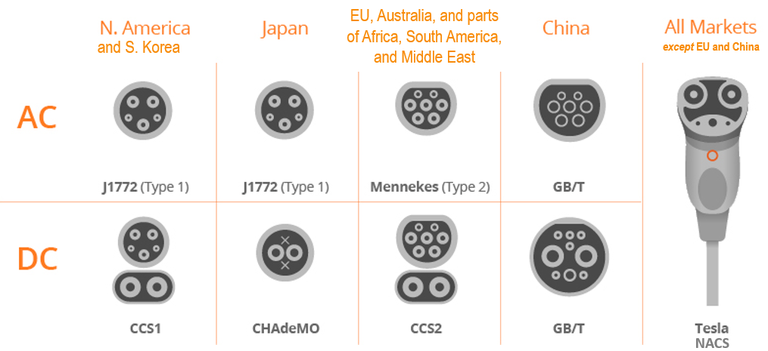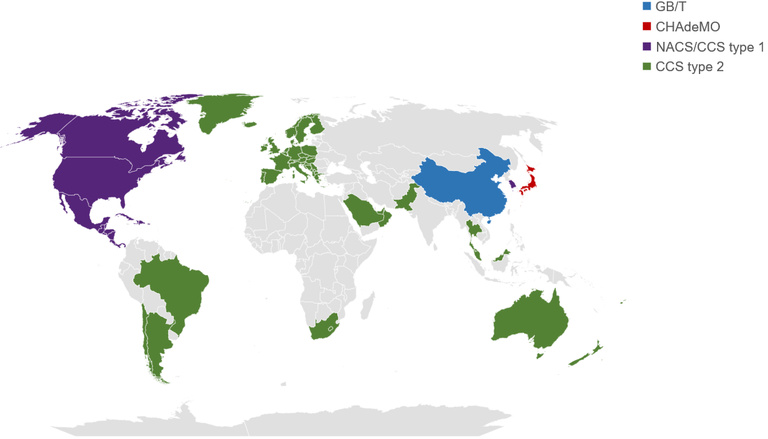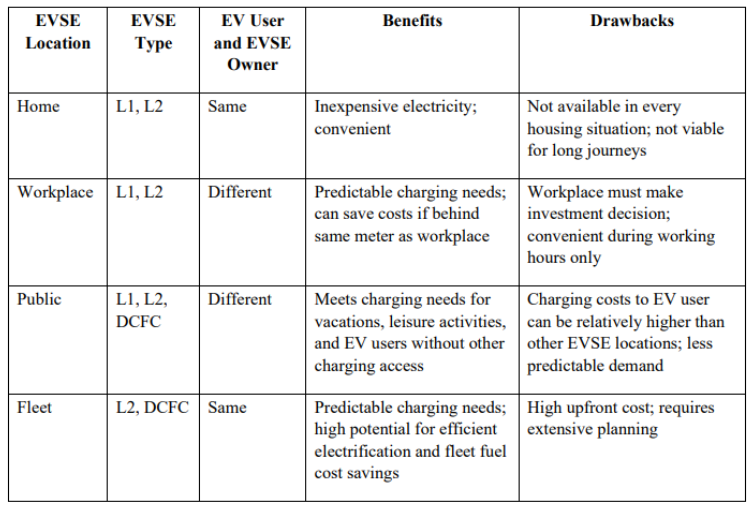Charging Infrastructure
Overview
Electric vehicle (EV) market development relies heavily on the availability of charging infrastructure, including both home and public charging options, which is essential for ensuring widespread adoption. Although most EV charging is conveniently done at home, public charging infrastructure is needed to ensure that EVs can reach all desired locations and to overcome range anxiety. This public network of EV charging infrastructure is crucial to support the broader use of EVs, much like the extensive network of petrol stations required for gasoline vehicles.
EV charging infrastructure comes in four major modes, as defined by the International Electrotechnical Commission (IEC), which each have distinct power characteristics:
- Mode 1: Charging an EV from a standard electrical outlet with a portable extension cord that lacks an IC-CPD (In-Cable Control and Protection Device). This mode has been banned in some countries due to the lack of fault and protection features.
- Mode 2: Charging an EV from a standard electrical outlet using a portable EV charging cable with an IC-CPD. This mode includes fault and protection features.
- Mode 3: Charging an EV from a permanently installed AC charger in either a residential or public setting. This mode includes fault protection features provided by an IC-CPD within the charging unit, as well as external communication features.
- Mode 4: Charging an EV from a permanently installed DC charger in a public setting. This mode includes fault protection features provided by an IC-CPD within the charging unit, along with external communication features.
Public charging stations complement home charging by enabling longer-distance travel and reducing range anxiety. While home charging primarily utilizes lower-power modes, Mode 4 provides high-power rapid charging at public locations to meet the demands of more extensive travel. Figure 1 summarizes these four EV charging modes per the IEC standard.
Figure 1. Four Modes of EV Charging per IEC Standard (Building Blocks of Electric Vehicle Deployment: A Guide for Developing Countries).

Figure 2: Common Charging Plugs Around the World (adapted from MJ Bradley & Associates).

The type of EV charging infrastructure is influenced by location and specific charging needs. Globally, home charging is common among early EV adopters, who tend to be more affluent and have access to dedicated parking, as seen in countries like the U.S. where electricity costs are relatively low. However, as EV prices decrease and adoption broadens to mainstream consumers, the need for public charging infrastructure will increase to accommodate drivers who lack home charging options. This is especially true in dense urban areas or multifamily housing, where installing home charging infrastructure is more challenging. In developing regions, where home charging availability is limited, there is a greater reliance on public or workplace charging options to support the growing EV market.
Workplace charging offers benefits due to predictable parking patterns and ease of implementation in dedicated spaces. Most workplace chargers use Level 1 (L1) or Level 2 (L2) equipment, as defined by the Society of Automobile Engineers (SAE) standard. L1 chargers use standard household electricity (120V), delivering 1–2 kW of power, which adds about 4 miles (6.4 km) of range per hour. L2 chargers, using higher voltage (240V), provide faster charging rates of 6.6–19 kW, adding up to 25 miles (40 km) of range per hour, though some EVs limit charging speeds to protect battery life. DC Fast Charging (DCFC) delivers 50–400 kW for rapid charging (up to 180 miles/290 km of range per hour), though not all EVs are compatible with DCFC, and frequent use can reduce battery longevity. Workplace chargers are often managed through partnerships with private developers, with cost savings mainly benefiting employees.
Figure 3. DC Fast Charging Standards by Location (adapted from Kane (2021) and populated with additional data by NREL).

Public charging infrastructure is critical in locations such as highways and city centers. These installations alleviate range anxiety and support long-distance travel. Despite potentially uncertain revenue, public charging can attract private investment due to the convenience it offers customers. Utilities may also need to manage grid upgrades to accommodate increased demand from public EV charging stations.
Fleet charging offers a unique advantage since fleet owners invest in both the EVs and the charging equipment, benefiting from reduced operational costs. Fleets often require higher upfront investments for DCFC or L2 chargers, but these are balanced by savings in fuel and maintenance. High-usage fleets may also use on-route or catenary charging to improve efficiency.
The below table shows a summary of charging station types and user behaviors, which are integral to both individual and fleet EV deployments. For specific considerations related to planning a fleet transition, see the Planning a Fleet Transition section.
Table 1. Summary of Common Charging Infrastructure Characteristics by Location (Building Blocks of Electric Vehicle Deployment: A Guide for Developing Countries).

Battery swapping is another option, allowing users to exchange depleted batteries for fully charged ones, which can reduce charging times and address range anxiety. Although this model faces challenges such as standardization and battery quality, it has shown promise for two- and three-wheel vehicles, especially in regions like South and East Asia.
Equity in EV charging infrastructure deployment is crucial. Issues of access arise when infrastructure is concentrated in affluent areas, potentially excluding lower-income users. Ensuring a variety of EV models and connector standards are supported addresses type equity, while price equity involves preventing high costs from deterring lower-income drivers. Public sector initiatives can help bridge these gaps, promoting fair access to charging infrastructure.
The question of whether EVs or EV charging infrastructure should come first depends on market dynamics and demand. Consumers may hesitate to purchase EVs due to a lack of charging stations, while potential investors might be reluctant to deploy EV charging infrastructure without a sufficient EV market. Strategic planning, including evaluating existing infrastructure and forecasting future demand, can help align EV charging infrastructure deployment with EV adoption to create a sustainable ecosystem for both. Building public charging infrastructure from fleet, residential, and workplace strongholds has also been a successful strategy to adopt EVs and EV charging infrastructure at the same time.
Key Actions for Robust Charging Infrastructure Development
Determining the optimal amount of EV charging infrastructure is complex and closely linked to the availability of vehicle and travel data. Accurate data helps predict the best locations for public charging stations. The goal is to provide enough infrastructure to support the growing number of EVs while avoiding unnecessary costs. Successful EV charging infrastructure deployment requires coordination among private investors, policymakers, city planners, and utilities. Project planning should be based on real-world data to ensure effective deployment, which contributes to a cohesive and efficient network of charging infrastructure.
- Invest in Data Collection and Analysis: Effective deployment of EVs requires upfront planning. Collecting and analyzing data on vehicle usage patterns, predicting charging behavior, and understanding infrastructure needs are helpful steps. This process includes using geolocation and telematics to gather insights on vehicle movements and charging needs, enabling more precise infrastructure development and management. Engaging stakeholders early and understanding electricity rates and diesel fuel prices are also important for a successful transition. This is discussed in more detail in the Planning a Fleet Transition Technical Theme.
- Determine Charging Infrastructure Needs: Effective deployment of EV charging infrastructure involves analyzing travel patterns, modes of transportation, and current and projected EV adoption rates to determine the number of charging stations needed. Data-driven decision-making helps avoid overbuilding and ensures that infrastructure development aligns with actual demand. This process also includes assessing different types of charging equipment, such as L1, L2, and DCFC, to meet diverse charging needs.
- Select and Implement Appropriate Charging Technologies: Choosing the right technology for EV charging equipment can be crucial for meeting performance and operational requirements. Assessing factors such as charging speeds, compatibility with various EV models, ability to respond to electricity price signals, and grid capacity can guide the selection process. Proactively planning for grid integration and potential upgrades can ensure that the chosen technologies operate efficiently within existing infrastructure.
- Assess Economic Impacts and Financial Viability: Understanding the economic implications of EV charging infrastructure deployment can help in making informed investment decisions. Analyzing costs related to installation, operation, and maintenance, alongside potential savings on fuel and maintenance, can provide a comprehensive view of financial feasibility. Financial models that account for capital expenses, incentives, long-term benefits, and indirect revenue streams such as advertising can support strategic investment choices.
- Plan for Operational and Maintenance Needs through Workforce Development: Planning for the ongoing operation and maintenance of charging infrastructure can ensure its long-term success. This can involve setting up new training programs for upskilling and reskilling maintenance staff and integrating EV charging equipment with existing infrastructure to facilitate smooth operations. Regular updates and maintenance schedules can help in addressing potential issues before they impact functionality.
- Incentivize and Support Equitable Access: To promote widespread adoption and equitable access to charging infrastructure, incentives for deploying EV charging equipment in underserved or less profitable areas can be beneficial. Public sector support and partnerships with private investors can help address disparities in infrastructure availability, ensuring that all communities have access to reliable charging options.
- Encourage Collaboration among Stakeholders: Collaborating with various stakeholders, including private investors, policymakers, city planners, and utility companies can enhance the planning and implementation of charging infrastructure. Coordinated efforts can help align objectives, share resources, and address challenges collaboratively to achieve a cohesive and efficient charging network.
In Colombia, the U.S. Agency for International Development (USAID) and National Renewable Energy Laboratory (NREL) Partnership has been instrumental in advancing EV infrastructure development in Bogotá through the USAID Colombia Young Leaders Workforce Training Program. The Partnership supports Grupo Energía Bogotá (GEB) and its collaborators in addressing critical questions related to EV charging infrastructure planning. The work includes determining the optimal number and locations of charging stations to meet projected demand, evaluating the types of charging stations needed, and assessing potential impacts on the grid and electricity demand. By leveraging tools like EVI-Pro and engaging in detailed spatial and socio-economic analyses, the USAID-NREL Partnership helps ensure that Bogotá's EV charging network is strategically planned and effectively implemented.
Read more about USAID-NREL Partnership projects here and explore how we are driving innovative solutions in clean energy and sustainable transport.
Resources
The State of Bidirectional Charging in 2023
Smart Electric Power Alliance (SEPA), 2023
This report provides an overview of the bidirectional charging industry, highlighting opportunities and barriers to its mass-market adoption through interviews with industry stakeholders and six detailed case studies on various applications of bidirectional charging technologies.
Research in Transportation Economics, 2021
This research paper addresses the chicken-and-egg dilemma between the development of EVs and the expansion of charging infrastructure, proposing a comprehensive planning scheme to resolve it. It analyzes the theoretical mechanisms of charging networks and EV development, introduces planning models to balance charging convenience and investment costs, and recommends a government subsidy scheme to promote EV adoption and support charging infrastructure expansion.
International Review of Electric Vehicle Charging Infrastructure and its Grid Integration - Report 2
NDC Transport Initiative for Asia (NDC-TIA), 2021
This second report in a four-part series on the Indian EV ecosystem provides an international perspective on EV charging infrastructure, grid integration, policy, and regulatory measures, with case studies and commercial implementations from the UK, USA, Germany, China, Norway, Denmark, the Netherlands, and Sweden. It includes analysis and demonstrations of EV charging technology and grid integration developments from these select countries.
Fundamentals of Electric Vehicle Charging Technology and its Grid Integration - Report 1
NDC-TIA, 2021
This report, focused on the Indian EV landscape, provides an overview of EV charging infrastructure, related policy and regulatory measures, and grid integration of EVs. This is the first in a series of four reports on the basics of EV charging infrastructure, standards, communication protocols, and grid integration of EVs.
Handbook of Electric Vehicle Charging Infrastructure Implementation
NITI Aayog, 2021
This handbook provides a comprehensive guide for planning, authorizing, and executing EV charging infrastructure in India. It outlines technological, regulatory, and governance frameworks necessary for successful implementation, tailored to India’s unique transport ecosystem, and aims to support stakeholders in developing a robust and contextually appropriate EV charging network.
The State of Managed Charging in 2021
Smart Electric Power Alliance (SEPA), 2021
This report highlights the necessity of managed charging programs for utilities to handle the growing EV market and its impact on the power system. It provides survey results, case studies, and recommendations for optimizing these programs, including the integration of new technologies like vehicle-to-grid (V2G) and vehicle telematics, to avoid distribution upgrade bottlenecks and reduce costs.
Electric Vehicle Charging Infrastructure: Business Model and Tariff Design Support to the Lao PDR
USAID-NREL Partnership, 2020
This presentation outlines the goals for deploying EVs and EVSE, examines the motivations behind EV and EVSE adoption from government and utility perspectives, and introduces different business models for implementing EVSE. While the context of the presentation focuses on Lao, the insights and strategies discussed are relevant to a broader audience interested in EV deployment and infrastructure development.
Quantifying the Tangible Value of Public Electric Vehicle Charging Infrastructure
NREL, 2020
This report addresses the challenge of investing in public recharging infrastructure for light-duty plug-in electric vehicles (PEVs) by quantifying the value that consumers place on such infrastructure. It estimates consumers’ willingness to pay for public charging stations based on factors such as vehicle range, recharging time, and existing infrastructure. Using simulation and econometric studies, the report develops functions to measure this willingness and finds that consumers value public EV charging infrastructure significantly, often in the thousands of dollars.
Utility Best Practices for EV Infrastructure Deployment
SEPA, 2020
This report provides recommendations for electric utilities to develop successful EV infrastructure programs, emphasizing the importance of strategic planning, team building, and customer experience to handle the projected 11% increase in U.S. electricity consumption due to EV charging by 2040.
Innovation Outlook: Smart Charging for Electric Vehicles
International Renewable Energy Agency (2019)
This innovation outlook explores the synergistic potential between variable renewable energy (VRE) sources, such as solar photovoltaics (PV) and wind power, and EVs. It examines how smart charging strategies could leverage this potential to enhance energy integration and efficiency up to the mid-century.
If you are interested in collaborating or learning more about the USAID-NREL Partnership's international sustainable transport and electric mobility initiatives, please contact us to learn more about partnership opportunities.

